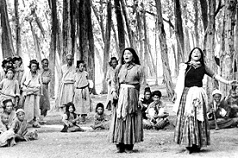The first thing we are going to indicate is the etymological origin of the term matriarchy that concerns us now. Specifically, we can state that it is a word that is the result of the sum of the following lexical components:
-The Latin noun “mater”, which means “mother”.
-The Greek element “arche”, which is used to indicate “power” or “principle”.
-The Latin suffix “-ado”, which is used to show “result”.
The notion of matriarchy refers to a form of social organization in which women hold power . By extension, the female preponderance in a group is called matriarchy.
 It is often stated that matriarchies developed in certain primitive peoples. However, there are those who claim that there is no historical evidence regarding the general predominance of women over men in any community.
It is often stated that matriarchies developed in certain primitive peoples. However, there are those who claim that there is no historical evidence regarding the general predominance of women over men in any community.
The idea of matriarchy, however, alludes to a type of society that has women occupying the main role in managing politics, the economy and family life. The opposite is patriarchy , where the man has control and authority.
Although gender equality is advancing around the world, most societies today are patriarchal . Numerous studies show that men hold top positions and earn more money than women. In a matriarchy, the situation would be reversed.
Beyond the debate about the existence of any matriarchy throughout history , anthropologists recognize matrilineality and matrilineage in different groups. A matrilineal organization, in this framework, is based on the prevalence of the maternal line. This means that the ascription of possessions and even social prestige comes through the mother and not the father.
In any case, matrilineage does not imply a matriarchy, although matriarchy includes matrilineage. In a matriarchy, the woman assumes leadership and sets the foundations of social interactions, leaving the man subordinate to her.
Currently it is considered that the largest matriarchy, the most extensive matriarchal society, that currently exists is in Sumatra, in Indonesia. This aforementioned society responds to the name of the Minangkabau, who have about 4.2 million members.
It is based on the woman transmitting the Adat, which is the philosophy that reigns in her and that is identified because it is more important to be than to have. Likewise, in this society its structure is made up of matrilineal clans and properties are inherited through women. What's more, apparently when a couple gets married, it is the husband who has to move to live in his wife's house. Not to mention that it is her family that pays a dowry to his family.
Likewise, another example of matriarchy is the one that exists in Tibet. We are referring to the Mosuo, which is a society in which each house has a matriarch and where property is inherited through the woman's line as well.
